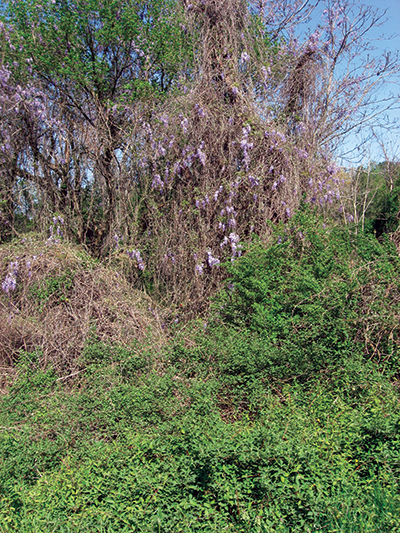Invasive Plants of Concern in Southeast Virginia and Regional Native Alternatives
(Left) Aggresive, invasive non-natives can quickly spread, cover, and kill native vegetation, such as this invasion of Asian Wisteria, Japanese Honeysuckle and Multi-flora Rose.
Invasive, non-native plants do not provide the same ecosystem services as natives and have a harmful effect on our environment, not only in the suburban community but also in our forests, parks, and other natural areas.
The non-native species listed are of particular concern in Southeast Virginia, and are currently ranked on the Virginia Invasive Plant Species List as exhibiting high (***), medium (**) or low (*) levels of invasiveness based on their threat to natural communities and native species.
Invasive: Akebia quinata, Chocolate Vine or Five-leaf Akebia **
Native Alternatives:
Gelsemium sempervirens, Carolina or Yellow Jessamine
Campsis radicans, Trumpet Creeper
Lonicera sempervirens, Trumpet or Coral Honeysuckle
Bignonia capreolata, Crossvine
Invasive: Ailanthus altissima, Tree of Heaven ***
Native Alternatives:
Cercis Canadensis, Eastern Redbud
Diospyros virginiana, Common Persimmon
Rhus copallinum, Winged or Shining Sumac
Invasive: Albizia julibrissin, Mimosa, Silk Tree **
Native Alternatives:
Amelanchier arborea and Amelanchier Canadensis, Serviceberry
Cercis canadensis, Eastern Redbud
Chionanthus virginicus, White Fringetree
Cornus amomum, Silky Dogwood
Lindera benzoin, Northern Spicebush
Betula nigra, River Birch
Invasive: Ampelopsis brevipedunculata, Porcelain-Berry ***
Native Alternatives:
Bignonia capreolata, Crossvine
Gelsemium sempervirens, Carolina or Yellow Jessamine;
Lonicera sempervirens, Trumpet or Coral Honeysuckle;
Invasive: Eleagnus umbellate, Autumn Olive ***
Native Alternatives:
Baccharis halimifolia, Groundsel
Cephalanthus occidentalis, Buttonbush
Clethra alnifolia, Sweet Pepperbush
Ilex vomitoria, Yaupon Holly; Ilex glabra, Inkberry Holly; Ilex vomitoria, Yaupon Holly
Itea virginica, Virginia Sweetspire
Sambucus Canadensis, Elderberry
Viburnum acerifolium, Viburnum nudiflorum and Viburnum prunifolium
Invasive: Hedera helix, English Ivy **
Native Alternatives:
Asarum canadense, Wild Ginger
Bignonia capreolata, Cross-vine
Galax urceolata, Galax
Gelsemium sempervirens, Yellow Jessamine
Mitchella repens, Partridge-Berry
Parthenocissus quinquefolia, Virginia-creeper
Packera aurea, Golden Ragwort
Invasive: Ligustrum sinense, Chinese Privet **
Native Alternatives:
Aronia arbutifolia, Red Chokeberry
Ilex glabra, Gallberry, Inkbery
Lindera benzoin, Northern Spicebush
Morella cerifera, Southern Bayberry, Wax Myrtle
Viburnum prunifolium, Black Haw
Invasive: Lonicera japonica, Japanese honeysuckle ***
Native Alternatives:
Bignonia capreolata, Cross-vine
Campsis radicans, Trumpet-creeper
Gelsemium sempervirens, Yellow Jessamine
Lonicera sempervirens, Trumpet or Coral Honeysuckle
Parthenocissus quinquefolia, Virginia-creeper
Passiflora incarnata, Purple Passionflower, Maypop
Invasive: Miscanthus sinensis, Miscanthus, Chinese Silvergrass **
Native Alternatives:
Panicum virgatum, Switchgrass
Learn More
Department of Conservation and Recreation, Division of Natural Heritage:
http://www.dcr.virginia.gov/natural-heritage/invspinfo
USDA National Invasive Species Information Center:
http://www.invasivespeciesinfo.gov/plants/main.shtml
Center for Invasive Species and Ecosystem Health:
http://www.invasive.org/species/weeds.cfm
Mistaken Identity–Invasive Plants and Their Native Look-Alikes (pub): https://www.nrcs.usda.gov/Internet/FSE_DOCUMENTS/nrcs144p2_024329.pdf
Plant Invaders of Mid-Atlantic Natural Areas (pub): https://www.invasive.org/eastern/midatlantic/


